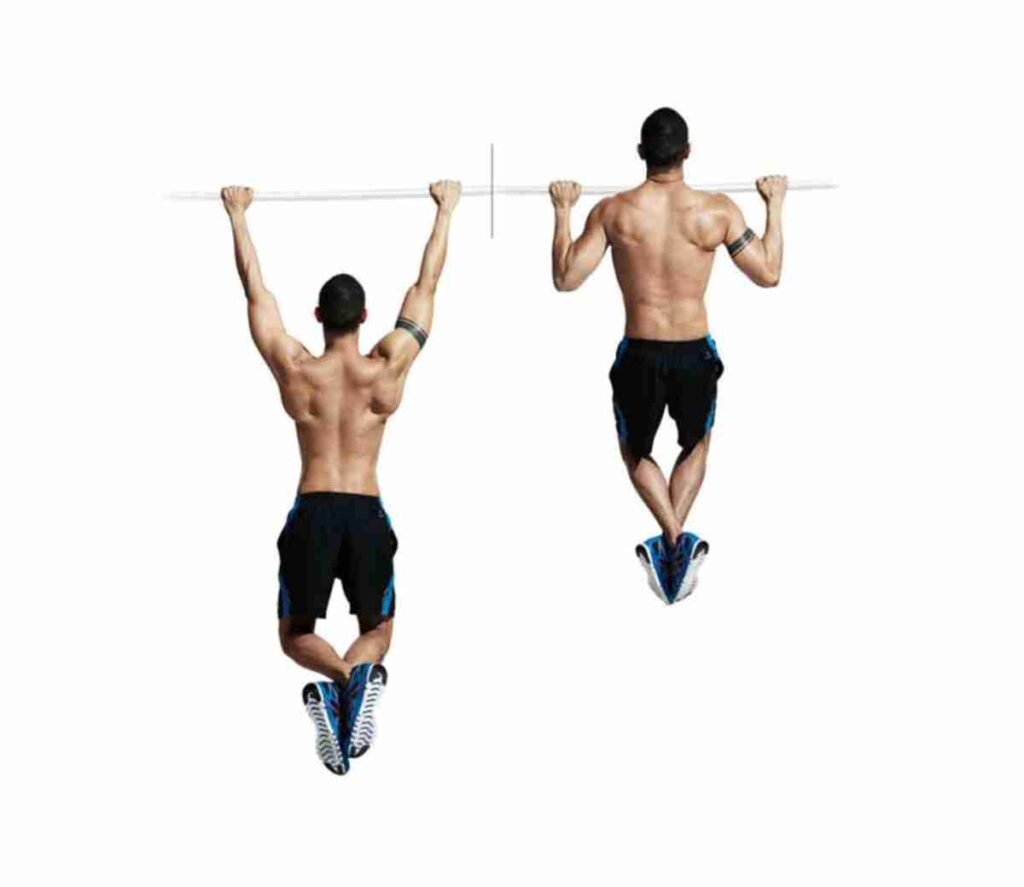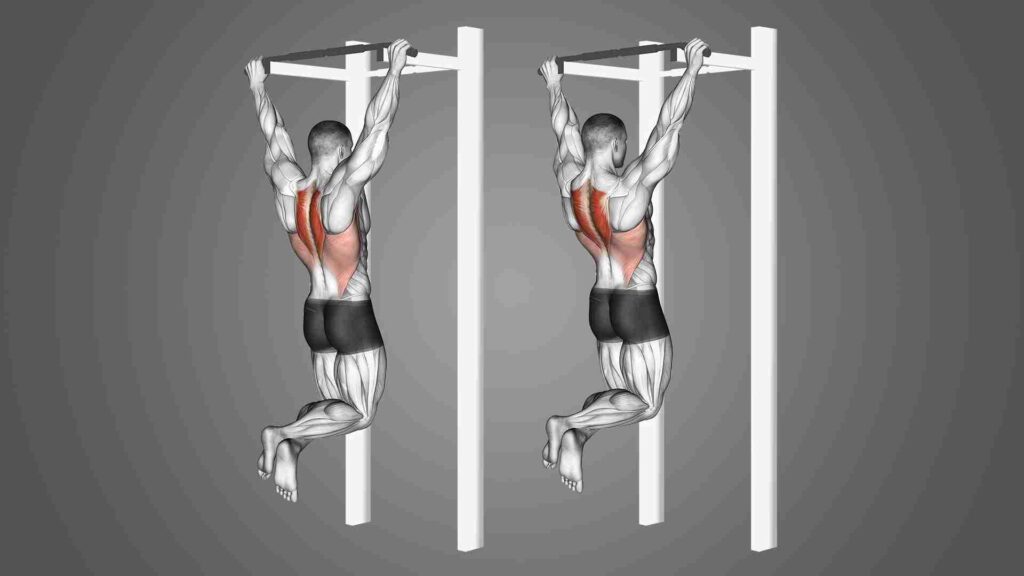Introduction
Are you ready to take your fitness journey to new heights? If you’re looking to strengthen your upper body, improve shoulder mobility, and transform your posture, scapular pull ups might just be the secret weapon you’ve been searching for. In this comprehensive guide, we’ll unravel the mysteries of scapular pull ups, giving you easy-to-follow insights and expert advice. By the time you’ve finished reading, you’ll have the knowledge and skills to make scapular pull ups a core component of your workout routine and rise to the top of your fitness game.
What are Scapular Pull-Ups?
Scapular pull ups, also known as scapular retraction or scapular engagement pull-ups, are a fundamental exercise designed to target the muscles responsible for the movement and stabilization of your shoulder blades, or scapulae. While they may appear similar to traditional pull-ups at first glance, scapular pull ups have a distinct focus on the scapular region, making them a valuable addition to any strength and mobility training routine.
SHOP FOR THE PULL-UP BAR ON AMAZON
In scapular pull ups, the primary objective is not to pull your entire body up to the bar or rings but to initiate and control the movement by engaging your scapulae. This exercise helps strengthen the muscles surrounding the scapulae, particularly the rhomboids and trapezius.
Importance of Scapular Health
Scapular health is often overlooked but plays a crucial role in maintaining shoulder function and overall well-being. The scapulae are not just passive structures in your upper body; they are dynamic, moving parts that contribute to several essential functions, including:
- Shoulder Stability: Strong and stable scapulae are essential for proper shoulder joint stability. This, in turn, reduces the risk of shoulder injuries.
- Posture: Well-functioning scapulae are integral to maintaining good posture. They help position the shoulders correctly and prevent rounded shoulders and slouching.
- Range of Motion: Scapular mobility is critical for your arms’ range of motion. Healthy scapulae allow for more fluid and pain-free movements in various daily activities and sports.
- Injury Prevention: Neglecting scapular health can lead to issues like shoulder impingement, rotator cuff injuries, and neck pain. Scapular pull ups can significantly contribute to injury prevention.
By incorporating scapular pull ups into your workout routine, you can proactively enhance the health of your scapulae, leading to better shoulder function, improved posture, and a reduced risk of shoulder-related problems.
Scapular Pull Ups vs. Regular Pull Ups
Pull-ups are a fundamental exercise that can help you build upper body strength, improve your posture, and enhance your overall fitness. However, there are different variations of pull-ups, and two of the most popular ones are Scapular Pull Ups and Regular Pull-Ups. Here, we’ll explore the key differences between these two exercises and help you determine which one is right for your fitness goals.
Scapular Pull-Ups:
- Primary Focus: Scapular pull ups primarily target the muscles responsible for scapular movement, particularly the trapezius and rhomboids.
- Exercise Description: During scapular pull ups, the goal is to move the scapulae (shoulder blades) without bending the elbows. You start from a hanging position and focus on retracting and depressing your shoulder blades while keeping your arms fully extended.
- Benefits: Scapular pull ups are exceptional for enhancing scapular mobility, strengthening the muscles responsible for good posture, and reducing the risk of shoulder injuries. They are often used as a warm-up or prehabilitation exercise.
- Difficulty Level: Scapular pull ups are generally easier for beginners to perform since they don’t require lifting the entire body weight.
- Variations: You can modify the grip width and the position of your hands on the bar to target different areas of the scapula and upper back.
Regular Pull-Ups:

- Primary Focus: Regular pull-ups, also known as chin-ups or pull-ups, primarily target the larger upper body muscles, including the lats, biceps, and deltoids.
- Exercise Description: During regular pull-ups, you lift your entire body weight by bending your elbows and pulling yourself up to the bar. This exercise requires considerable upper body strength.
- Benefits: Regular pull-ups are excellent for building overall upper body strength, enhancing your grip, and increasing the size and definition of your back and arm muscles. They are a staple exercise for many strength and conditioning programs.
- Difficulty Level: Regular pull-ups are often more challenging, especially for beginners, due to the greater amount of weight being lifted and the involvement of various muscle groups.
- Variations: You can modify regular pull-ups by changing your grip (wide, narrow, underhand, overhand) or by adding extra weight through a weight belt or weighted vest.
Which Should You Choose?
The choice between scapular pull ups and regular pull-ups ultimately depends on your fitness goals and your current fitness level. Here are some general guidelines:
Choose Scapular Pull Ups if:
- You are a beginner or new to pull-up exercises.
- You have shoulder issues or want to focus on shoulder health.
- You want to improve your posture.
- You’re looking for a low-intensity exercise to include in your routine.
Choose Regular Pull Ups if:
- You have a moderate to advanced level of upper body strength.
- You want to build muscle and increase overall upper body power.
- You enjoy challenging exercises.
- You’re interested in a full-body workout.
SHOP FOR THE RESISTANCE BAND ON AMAZON
In conclusion, both scapular pull ups and regular pull-ups have their unique benefits, and they can complement each other in a well-rounded workout routine. Consider your fitness goals, current abilities, and any specific concerns about shoulder health when deciding which pull-up variation is right for you.
Proper Form and Technique

Mastering the correct form and technique for scapular pull ups is crucial to ensure that you get the maximum benefit from this exercise while minimizing the risk of injury. Here, we will provide you with step-by-step instructions to perform scapular pull ups with precision.
Step-by-Step Guide
Grip the Bar:
- Begin by approaching a pull-up bar with your palms facing away from your body.
- Grasp the bar with a grip slightly wider than shoulder-width apart.
Hanging Position:
- Hang freely from the bar with your arms fully extended.
- Relax your shoulders and let them fully depress, so your body is in a passive, ‘dead hang’ position.
Scapular Engagement:
- Start the movement by engaging your scapulae (shoulder blades).
- Without bending your arms or pulling your body upward, initiate the motion by retracting your shoulder blades, pulling them back and together.
- This should feel like you’re trying to squeeze a pencil between your shoulder blades.
Hold and Squeeze:
- Once your scapulae are fully retracted, hold the position for a moment, squeezing your shoulder blades together as tightly as possible.
- Keep your arms straight and focus solely on your shoulder blade movement.
Release the Scapulae:
- After squeezing your scapulae together, reverse the motion.
- Allow your shoulder blades to protract, moving away from each other.
- Your body will move slightly away from the bar as your shoulder blades move apart.
Repeat the Process:
- Perform these scapular pull ups with controlled movements.
- Aim for a set number of repetitions, keeping your form precise throughout.
Common Mistakes to Avoid
Bending Your Arms: One of the most common mistakes is bending your arms during scapular pull ups. Remember that this exercise primarily targets your scapulae, not your biceps.
Incomplete Range of Motion: Ensure that you fully retract and protract your shoulder blades. Failing to do so diminishes the effectiveness of the exercise.
Using Momentum: Avoid swinging or using momentum to pull your body up and down. Keep the movement controlled and deliberate.
KEY BENEFITS OF POSTNATAL PILATES
Overarching the Back: Maintain a neutral spine position during scapular pull-ups. Avoid arching your lower back excessively.
Tips for Beginners
If you’re new to scapular pull-ups, it’s essential to start with the basics and gradually progress. Here are some tips to help beginners:
- Begin with a wider grip for added stability.
- Perform scapular pull-ups with your feet supported on the ground, or use an assistance band to reduce the load.
- Focus on feeling the engagement of your shoulder blades in each repetition before attempting more challenging variations.
SHOP FOR THE PULL-UP GLOVES ON AMAZON
By mastering the form and technique of scapular pull-ups, you’ll lay a strong foundation for reaping the full benefits of this exercise. Remember to practice regularly and be patient with your progress, and soon you’ll be on your way to achieving scapular strength and enhanced shoulder mobility.
Variations of Scapular Pull-Ups
Scapular pull-ups are a versatile exercise that can be modified to suit various fitness levels and goals. Here, we’ll explore different variations of scapular pull-ups, allowing you to customize your workout routine and target specific muscle groups. Whether you’re a beginner looking to build strength or an advanced athlete seeking a new challenge, there’s a scapular pull-up variation for you.
1. Wide-Grip Scapular Pull-Ups:
- Instead of using a shoulder-width grip on the pull-up bar, place your hands wider apart. This variation emphasizes the engagement of the lats and broadens your upper back.
- Benefits: Works the lats and increases the challenge for the scapular muscles.
2. Narrow-Grip Scapular Pull-Ups:
- Position your hands closer together on the pull-up bar. A narrow grip places more stress on your biceps and inner back muscles.
- Benefits: Targets the biceps and inner back, helping you develop arm and upper back strength.
3. Hanging Scapular Pull-Ups:
- In this variation, you start in a hanging position with your arms fully extended and focus on engaging the scapular muscles while pulling yourself up. You can hang from a bar or gymnastic rings.
- Benefits: Enhances grip strength, scapular control, and shoulder mobility.
4. Bar Scapular Pull-Ups:
- Instead of using a pull-up bar, this variation involves a Smith machine or a fixed horizontal bar. You can adjust the bar’s height to your preference.
- Benefits: Allows for easier progression and customization of the exercise, making it suitable for all fitness levels.
5. Adding Resistance:
- To increase the challenge, you can add weight in various ways, such as using a weight belt with a plate or holding a dumbbell between your feet while performing scapular pull-ups.
- Benefits: Intensifies the workout and helps you build more strength and muscle.
6. Isometric Scapular Pull-Ups:
- Perform scapular pull-ups as usual but pause and hold your scapulae in the contracted position for a few seconds at the top of the movement. This increases time under tension and enhances scapular muscle endurance.
- Benefits: Improves scapular stability and endurance, which is particularly helpful for athletes in sports like rock climbing.
7. One-Arm Scapular Pull-Ups:
- A challenging variation where you perform scapular pull-ups with one arm while the other arm assists minimally.
- Benefits: Enhances unilateral strength and muscle development, requiring a high level of scapular control.
8. Towel Scapular Pull-Ups:
- Hang a towel or resistance band over the pull-up bar, grip it with both hands, and perform scapular pull-ups. This variation engages your grip strength and scapular muscles simultaneously.
- Benefits: Builds grip strength and scapular stability, offering a unique challenge.
Will I Lose Muscle If I Don’t Eat Carbs After Workout?
When incorporating these variations into your workout routine, it’s essential to maintain proper form and gradually progress as your strength improves. Experiment with different variations to keep your workouts interesting and ensure well-rounded upper body development.
FAQs
Q 1. What muscles do scapular pull-ups work?
Ans. Scapular pull-ups primarily target the muscles in the upper back, including the trapezius, rhomboids, and rear deltoids. They also engage the biceps and forearm muscles to a certain extent.
Q 2. Are scapular pull-ups suitable for beginners?
Ans. Scapular pull-ups can be adapted for beginners by starting with hanging scapular retractions and gradually progressing to full scapular pull-ups as strength and skill develop.
Q 3. Can scapular pull-ups cause shoulder pain?
Ans. When performed with proper form and adequate warm-up, scapular pull-ups should not cause shoulder pain. However, if you have pre-existing shoulder issues, it’s advisable to consult a healthcare professional before attempting this exercise.
Q 4. Do scapular pull-ups help with posture correction?
Ans. Yes, scapular pull-ups are effective in improving posture. By strengthening the muscles responsible for scapular stability, they can help counteract the negative effects of slouching and poor posture.
Conclusion
In conclusion, scapular pull-ups are a highly effective exercise that can significantly contribute to your upper body strength, shoulder mobility, and overall fitness. By incorporating this exercise into your routine, you can experience improved posture, injury prevention, and a range of physical benefits. Remember to maintain proper form, progress gradually, and listen to your body to ensure a safe and effective training experience.

Good day, and welcome to Fitthour. My name is Shubham Vijay, and I am a certified personal trainer and nutrition coach with 6 years of experience in the fitness industry. At Fitthour, we specialize in types of training, such as strength training, cardio, or HIIT, and our mission is to help clients achieve their fitness goals and improve their overall health.




